Acetate c₂h₃o₂⁻ - Study guides, Class notes & Summaries
Looking for the best study guides, study notes and summaries about Acetate c₂h₃o₂⁻? On this page you'll find 275 study documents about Acetate c₂h₃o₂⁻.
All 275 results
Sort by
 Popular
Popular
-
Chem 103 Module 1 to 6 Exam with Verified answers (100 OUT OF 100) Portage learning (Latest Update)
- Exam (elaborations) • 35 pages • 2024
- Available in package deal
-
- $20.49
- 15x sold
- + learn more
Chem 103 Module 1 to 6 Exam with Verified answers (100 OUT OF 100) Portage learning (Latest Update) MODULE 1 EXAM Question 1 Click this link to access the Periodic Table. This may be helpful throughout the exam. 1. Convert 845.3 to exponential form and explain your answer. 2. Convert 3.21 x 10-5 to ordinary form and explain your answer. 1. Convert 845.3 = larger than 1 = positive exponent, move decimal 2 places = 8.453 x 102 2. Convert 3.21 x 10-5 = negative exponent = smalle...
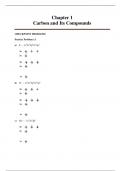 Popular
Popular
-
Solution Manual for Organic Chemistry Mechanistic Patterns Canadian 1st Edition Ogilvie Ackroyd Br
- Exam (elaborations) • 809 pages • 2024 Popular
-
- $48.48
- 1x sold
- + learn more
Chapter 1 Carbon and Its Compounds CHECKPOINT PROBLEMS Practice Problem 1.1 a) S — 1s2 2s2 2p6 3s2 3p4 b) Cl — 1s2 2s2 2p6 3s2 3p5 c) Na+ — 1s2 2s2 2p6 1-2 Copyright © 2018 Nelson Education Limited Practice Problem 1.2 a) Count valence electrons. Build a basic bonding framework and account for electrons used. Add remaining electrons and check for formal charges. The molecule has a lone pair on the nitrogen. All other electrons are bonding electrons. b) Count valence...
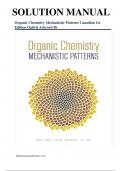
-
Solution Manual for Organic Chemistry Mechanistic Patterns Canadian 1st Edition by Ogilvie Ackroyd Br
- Exam (elaborations) • 811 pages • 2024
-
- $19.99
- 1x sold
- + learn more
Chapter 1 Carbon and Its Compounds CHECKPOINT PROBLEMS Practice Problem 1.1 a) S — 1s2 2s2 2p6 3s2 3p4 b) Cl — 1s2 2s2 2p6 3s2 3p5 c) Na+ — 1s2 2s2 2p6 1-2 Copyright © 2018 Nelson Education Limited Practice Problem 1.2 a) Count valence electrons. Build a basic bonding framework and account for electrons used. Add remaining electrons and check for formal charges. The molecule has a lone pair on the nitrogen. All other electrons are bonding electrons. b) Count valence electrons. Build a bas...

-
Test Bank For Organic Chemistry 9th Edition by John E. McMurry
- Exam (elaborations) • 555 pages • 2023
- Available in package deal
-
- $33.79
- 2x sold
- + learn more
Chapter 01 - Structure and Bonding 1. Give the ground-state electron configuration for carbon (atomic number 6). 1s22s22px12py1 or 1s22s22p2 2. Give the ground-state electron configuration for fluorine (atomic number 9). ANSWER: POINTS: 1 1s22s22px2 2py2 2pz1 or 1s22s22p5 3. Give the ground-state electron configuration for magnesium (atomic number 12). 1s22s22p63s2 4. How many electrons does silicon have in its valence shell? ANSWER: four POINTS: 1 Exhibit 1-1 Write valid Lewis (elec...
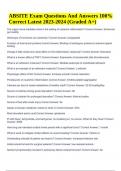
-
ABSITE Exam Questions And Answers 100% Correct Latest 2023-2024 (Graded A+)
- Exam (elaborations) • 22 pages • 2023
-
- $15.49
- 1x sold
- + learn more
ABSITE Exam Questions And Answers 100% Correct Latest (Graded A+). The vagus nerve mediates what in the setting of systemic inflammation? Correct Answer: Enhanced gut motility What type of hormones are cytokines? Correct Answer: polypeptide Function of heat shock proteins Correct Answer: Binding of autologous proteins to improve ligand binding Omega-3 fatty acids have what affect on the inflammatory response? Correct Answer: Decrease What is a known affect of TNF? Correct Answer: Expressi...
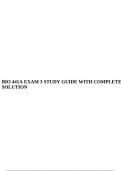
-
BIO 441A EXAM 3 STUDY GUIDE WITH COMPLETE SOLUTION.
- Exam (elaborations) • 20 pages • 2024
-
- $12.99
- + learn more
BIO 441A EXAM 3 STUDY GUIDE WITH COMPLETE SOLUTION. LECTURE ONE - METABOLISM INTRODUCTION ● Autotrophs synthesize all their own cellular constituents from simple molecules ● Heterotrophs obtain energy through oxidation of organic compounds and therefore rely on autotrophs ● Metabolism involves many reactions such as ○ Glycolysis/gluconeogenesis ○ The citric acid cycle ○ Oxidative phosphorylation ● Catabolism is the degradation of biomolecules ○ Energy rich nutrients are...
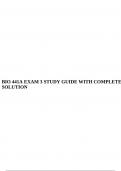
-
BIO 441A EXAM 3 STUDY GUIDE WITH COMPLETE SOLUTION.
- Other • 20 pages • 2024
-
- $12.99
- + learn more
BIO 441A EXAM 3 STUDY GUIDE WITH COMPLETE SOLUTION. LECTURE ONE - METABOLISM INTRODUCTION ● Autotrophs synthesize all their own cellular constituents from simple molecules ● Heterotrophs obtain energy through oxidation of organic compounds and therefore rely on autotrophs ● Metabolism involves many reactions such as ○ Glycolysis/gluconeogenesis ○ The citric acid cycle ○ Oxidative phosphorylation ● Catabolism is the degradation of biomolecules ○ Energy rich nutrients are...
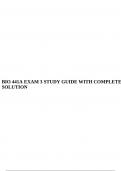
-
BIO 441A EXAM 3 STUDY GUIDE WITH COMPLETE SOLUTION.
- Exam (elaborations) • 20 pages • 2024
-
- $12.99
- + learn more
BIO 441A EXAM 3 STUDY GUIDE WITH COMPLETE SOLUTION. LECTURE ONE - METABOLISM INTRODUCTION ● Autotrophs synthesize all their own cellular constituents from simple molecules ● Heterotrophs obtain energy through oxidation of organic compounds and therefore rely on autotrophs ● Metabolism involves many reactions such as ○ Glycolysis/gluconeogenesis ○ The citric acid cycle ○ Oxidative phosphorylation ● Catabolism is the degradation of biomolecules ○ Energy rich nutrients are...
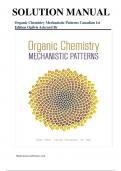
-
Solution Manual for Organic Chemistry Mechanistic Patterns Canadian 1st Edition by Ogilvie Ackroyd Br
- Exam (elaborations) • 811 pages • 2024
-
- $19.99
- + learn more
Chapter 1 Carbon and Its Compounds CHECKPOINT PROBLEMS Practice Problem 1.1 a) S — 1s2 2s2 2p6 3s2 3p4 b) Cl — 1s2 2s2 2p6 3s2 3p5 c) Na+ — 1s2 2s2 2p6 1-2 Copyright © 2018 Nelson Education Limited Practice Problem 1.2 a) Count valence electrons. Build a basic bonding framework and account for electrons used. Add remaining electrons and check for formal charges. The molecule has a lone pair on the nitrogen. All other electrons are bonding electrons. b) Count valence electrons. Build a bas...
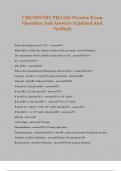
-
CHEMISTRY PRAXIS Practice Exam Questions And Answers (Updated And Verified)
- Exam (elaborations) • 20 pages • 2024
-
- $13.49
- + learn more
CHEMISTRY PRAXIS Practice Exam Questions And Answers (Updated And Verified) What is the negative log of 1 X10⁻⁷ - answer7 When [H₃O⁺] = [OH⁻] the solution is acidic or basic or neutral - answerneutral The concentration of H₃O⁺ and OH⁻ in pure water at 25°C - answer1X10⁻⁷ Kw - answer1X10⁻¹⁴ pH + pOH = - answer14 What is the concentration of Hydrogen ion when the pH is 2 - answer1X10⁻² Using the - log [H⁺] or - log [H₃O⁺] helps you find the - answerpH U...
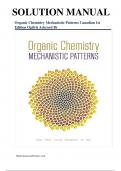
-
Solution Manual for Organic Chemistry Mechanistic Patterns Canadian 1st Edition by Ogilvie Ackroyd Br
- Exam (elaborations) • 811 pages • 2024
-
- $19.99
- + learn more
Chapter 1 Carbon and Its Compounds CHECKPOINT PROBLEMS Practice Problem 1.1 a) S — 1s2 2s2 2p6 3s2 3p4 b) Cl — 1s2 2s2 2p6 3s2 3p5 c) Na+ — 1s2 2s2 2p6 1-2 Copyright © 2018 Nelson Education Limited Practice Problem 1.2 a) Count valence electrons. Build a basic bonding framework and account for electrons used. Add remaining electrons and check for formal charges. The molecule has a lone pair on the nitrogen. All other electrons are bonding electrons. b) Count valence electrons. Build a bas...

How did he do that? By selling his study resources on Stuvia. Try it yourself! Discover all about earning on Stuvia


